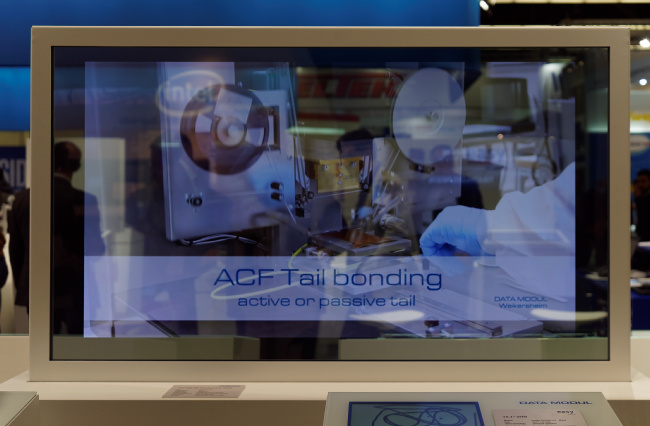When we met with Data Modul at the recent Embedded World show, we promised to cover the transparent OLED that it showed when we got to PTE as we knew that there would only be very limited new hardware. The company is gradually moving to use the Data Modul name, although Conrac is still very well known in FIDs.
The transparent OLED was being shown as a “technology demonstration” rather than as a final product and we were told that there had been a lot of interest in the idea of using it already (we were there at the end of the first of two days). The display is, of course, based on the 45% transparency panel that Samsung Display has been showing, but Data Modul has bonded the panel to a 6mm sheet of safety glass to make it more robust. Brightness was quoted at a peak of 450 cd/m² (but not if you want to show a full white screen). Colour is 100% of AdobeRGB and contrast is quoted at 1,000,000:1 to 1.
 Sorry – our picture of flight information was out of focus – so here is the DataModul transparent display shown at Embedded World. Image:Meko
Sorry – our picture of flight information was out of focus – so here is the DataModul transparent display shown at Embedded World. Image:Meko
As we have previously reported from Eyevis, which is also developing products based on the panel, there are limits in terms of usage and the ambient environment for use as well as potential image sticking issues. We did found out that the maximum temperature for operations is 50ºC, which is not too bad if the panel is kept well away from bright ambient, which we have previously heard is a limitation on this panel, anyway. We also noted that the demo on the Data Modul display was switching quite quickly, which obviously minimises burn-in.
Other than the transparent display, there were no other new hardware products as we have reported others before.
Analyst Comment
It was only when I was writing up this report that I realised that the contrast measurement on this panel is a bit ridiculous. After all, the panel cannot really show black unless it is in a completely black room, in which case, the transparency is kind of pointless!
As I mentioned a couple of weeks ago after the Samsung talk at Electronic Display, I believe that the long term goal of this display is to be embedded in windscreens. As I mentioned a couple of weeks ago, to do this, the transparency needs to get up to around 90%. It was pointed out at Data Modul that one of the requirements of automotive glass is that it retains its transparency when damaged. That could also be a barrier that needs to be overcome for the OLED. (BR)

